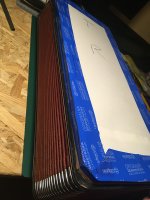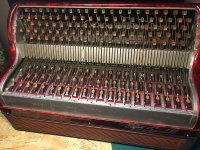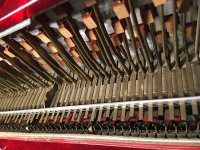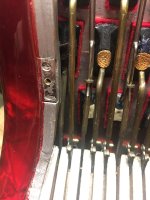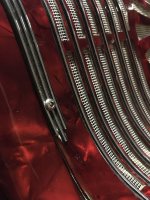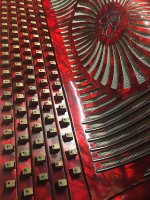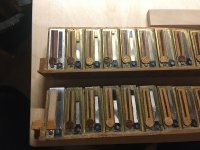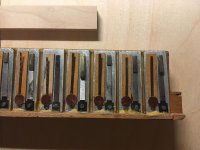This box came with very nice, real mother of pearl buttons. They have of course yellowed and dimmed with time, some of them were also unpleasantly rough to the touch and sadly one is missing. I'm hunting for a suitable replacement, but to no avail so far. Perhaps one of you might have a spare, old, yellowed, 15,5-16mm real mother of pearl button lying around?

After a proper bath in mineral oil they are now very nicely smooth and look great. I decided to provide myself a subtle learning aid in the form of differently coloured bumper felts, that follow the B-system layout. The keyboard required significant re-levelling after screwing the buttons back, which in turn forced me to adjust declassement coupler yet again...
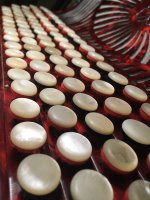

But with that done, the aesthetical and mechanical renovation of the treble side is done!
So, now it's time for acoustics. This box will be 100% played at home, so it needed toning the volume and timbre down to levels that allow proper practice sessions in small closed spaces without my head exploding. In order to do that, I installed leather baffles (full airtight seal) under the grille and in the declassement opening behind the keyboard. Now the main source of sound and an air intake/exhale is through the keyboard. The sound is now way nicer, full but smoothed out. L register is now more "woodwind" in nature and M voices (brass plates) lost some of the harsher metalic overtones and now sound nicely trumpet like. However, that doesn't solve the main issues. There are two, one with the box, and one with... me.
First, the issue with the box. As I mentioned before, the lowest octave of the L voice is not there. It's annoying, as it shortens the useful range of LM/LMM configuration compared to M/MM, which results in the paradoxically higher overal sound of those configurations. I can source the missing reeds, but since those missing reeds need to be up to 11mm longer, I'll have to modify the bellows frame to accommodate the necessary higher reedblock. I have a nice idea how to fit this aesthetically with the rest of the box, thanks to the Art Deco design of it. However, I currently don't have the capacity to do this properly - I'm in the middle of the from-the-ground-up renovation of my workshop, currently on hold due to spine injury. So I don't know when I'll be able to do this.
In the mean time, I may be able to resolve the second issue, the one with me. This box is LMM, originally tuned very wet, around minus 22 cents (everythinng is out of tune by a couple of cents, so it's hard to tell what tunning it was in exactly). When I first discovered the issue with the lowest L octave I contemplatet turning this into MMM box and have a full musette box. But as it turns out, my neurological condition objected to this idea. You see, I'm an epileptic, and while recordings of musette accordions are completely harmless, having a fast tremolo live, loud, and so close to my ears creates a phase shift issue equivalent to strobe lights. So wet tuning is now out of the question, but adjusting reeds up by 20 cents to a slight detune of 2-4 cents is a serious strain on the reeds. I also don't really like piccolo reeds and H register, so there is very little incentive to rebuild the box to LMH... I had another idea, to replace the brass M- voice with a zinc M and have a third base timbre, but it would double the cost of the whole box when ordered new from harmonicas.cz. But by fortunate coincidence I managed to source an almost full voice (G2-E6) of reclaimed zinc DIX reeds! They're on the way. I don't know the scaling, so if I'll have to significantly rebuild the reedblocs to fit them, this modification will also have to wait for the end of my workshop renovation.

